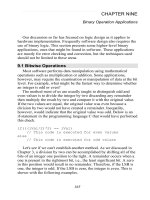Ebook How computers work (8th edition) Part 2
Bạn đang xem bản rút gọn của tài liệu. Xem và tải ngay bản đầy đủ của tài liệu tại đây (38.96 MB, 191 trang )
Games and
Multimedia
H
A
p
T
E
R
s
Ii PHR 2
HOW MULTIMEDIA SOUND WORKS
268
2
HOW MULTIMEDIA VIDEO WORKS
280
HOW GAMES PUT YOU IN THE ACTION
286
264
GAMES AND MULTIMEDIA
If you could do whatever you wanted, it wouldn't be agame.
-Clive Thompson
First video game
Developed at MIT, Spacewar made its debut in 1962. Here
is the classic CBS Opening. The ships-one wedge-shaped
and the other with a needle-nose-turn slightly away from the
I
star and fire a short rocket blast (note the needle-ship's
exhaust) to get into a comet-type orbit, and then rotate the
other way to try shooting torpedoes at the opponent.
The original IBM PC, compared to today's personal computers, was a poor, introverted little thing. It didn't speak, sing,
or play the guitar. It didn't even display graphics well or
show more than four colors at a time. Not only is today's
multimedia revolution changing the ways we use PCs, it also
is changing our use of information itself. Where information
formerly was defined as columns
of numbers or pages of
text, we're communicating both to and from our PCs, using
our voices, our ears, and our eyes, not simply to read, but to
see pure visuals.
Today the distinctions among computers, movies, television,
radio, CD players, DVD players, TiVo, and game consoles have all but disappeared.
They are losing their individual identities to be co-opted, Borg-like, into one allencompassing, networked system that serves up entertainment, information, and communication throughout the home and the work place. Add the cell phone, which is rapidly
morphing into an extension of this computer/entertainment/communication personal conglomerate, and the boundaries of the home and office dissolve, too.
We are headed quickly toward the utopian idea of pervasive computing. Expect other
devices to join the party. Sensors in the walls, in your bed, or in your cereal will be able
to monitor your blood pressure, cholesterol, diet, and provide your doctor with a video
view of your alimentary canal without you realizing any
of it. As you play squash-
OVERVIEW
265
prescribed because microanalyzers in your vitamin pill radioed back a less than ideal
body fat ratio-an ear bud whispers a warning that the stock you're watching shows
signs of a collapse. Without missing a stroke, you whisper back to
se!!.
If all this turns out to be true, you can thank a bunch of computer
hackers-an admirable term back then-who in 1961 had been
set loose on a new PDP-1 computer in the laboratory basement at
MIT. Without someone like them, computers would very likely have
remained tools for crunching drab numbers and data, text-only
machines that would have been only a glorified combination of
typewriter, adding machine, and card catalog. But the MIT hackers
nudged computing in the right direction to develop, after decades
of growth, into talking, breathing, listening, living machines that
are a part of our world and that invite us into their virtual worlds.
After creating from scratch the basic software-compilers, debuggers, and text editors-needed by any computer to write real programs, the hackers plunged into creating a serious piece of software: Spacewar. The game began as cute graphics
demonstration that allowed three points of light to interact with each other based on
parameters entered at the keyboard. The three points of light quickly evolved into a star
and a couple of spaceships, which soon developed the ability to fire torpedoes in the
form of even smaller dots of lights. There was a realism to the game that most computer
games for the next couple of decades didn't have. The objects followed laws of physics.
The ships had to overcome inertia to get moving and overcome inertia to stop. The
sun's gravity affected their paths and those of the torpedoes, and Spacewar allowed
you to reverse the laws so the sun repelled objects instead of attracting them.
It wasn't until 1992 that computing took its next big step toward creating virtual worlds,
although few back then could have seen where it was headed. id Software distributed
a free game called Wolfenstein 3D. The back story was that you were a soldier on the
loose in a Nazi prison. You had to fight your way through several levels full of enemy
soldiers, vicious dogs, and the Big Boss himself.
Wolfenstein 3D
The graphics were crude in the] 992
game, but the obilily to move freely
in a 3D world was exciting and 0
maior step toward virtual reality.
GAMES AND MULTIMEDIA
266
The graphics were crude. But it had a grabber: It was modeled on a 3D environment
that enabled you to move in any direction you wanted. Most games until then had a predetermined course to follow. Wolfenstein 3D let you go and do what you wanted. The
enemy soldiers had a primitive artificial intelligence that enabled them to react to what
you did. (Fire your gun, for instance, and they might hear you and come running.)
Wolfenstein 3D was followed by id/s Doom, which was
Wolfenstein 3D on a big budget and with all imaginative
shackles cast off. The popularity
of Doom
and all its imitators
spurred the development of video cards and sound cards
that could more realistically render a 3D environment, which
made it possible for software developers and artists to create
more and more realistic games until they've reached the
point today where each blade of grass and every strand of
hair can move in individual reaction to a 3D world.
Games have brought us to the point that our world and
___
~.J
game worlds are separated by only a thin fabric of reality.
It's easy to become caught up in these games and easy to
1989 HDTV
The first experimental highdefinition display in 1989 illustrates
the difference between it (on the
leftl and the interlace technology
used by conventional television.
Courtesy of Lucent
Technologies
see how they have already overlapped into television and movies, where some characters exist only as creatures of a computer performing next to f1esh-and-blood actors.
We're in the next big revolution without knowing it. It's a revolution that enables a 3D
model to contain an entire virtual world as a collection
of software
files, a database
of
objects, and their locations in the virtual world. Join in the 3D world through your computer, your TV, and maybe soon through your cell phone, and the database records your
movements and your position and those of thousands of others in the same gameworld. It
gathers information about what you should be seeing, hearing, and feeling and transforms that data into changes you see on the monitor; hear on your 3D, spatialized
speakers; and feel in your force feedback joystick. If it keeps on like this, soon, very
soon, we might stay home for a visit to virtual reality more often than we leave the house
to visit real reality.
OVERVIEW
3D graphics
Not the same as 3D movies, in which
you have a sense of depth. Instead, computer animation,
rendered in real time, in which you can infinitely change
the viewpoint.
AVI
Acronym for audio/video interleave, one of the
most common file formats that combines video and
sound.
bitmaps Graphics designed to look like skin, clothing, brick walls, and other 3D objects in games or virtual
reality.
frame rate
Speed of animation, usually expressed in
frames per second.
laser
Originally an acronym for light amplification by
stimulated emission of radiation, a laser is a device that
produces a coherent beam of light. That is, the beam
contains one or more extremely pure colors and remains
parallel for long distances instead of spreading as light
normally does.
MID!
Acronym for musical instrument digital interface,
MIDI is a protocol for recording and playing back music
on digital synthesizers supported by most sound cards.
Rather than representing musical sound directly, it contains information about how music is produced. The
resulting sound waves are generated from those already
stored in a wavetable in the receiving instrument or
sound card.
MMORPG
Acronym for massively multiplayer online
roleplaying game, a computer role-playing game that
enables thousands of players to play at the same time
and interact with each other in an evolving virtual world
over the Internet.
MP3
An audio file compressed so that it's one-tenth
the size of the original sound file. The compression technique is based on the third layer of MPEG, a scheme
devised for compressing video as well as sound.
rasterizer Gaming software that translates the 3D
geometry of 3D obiects to a two-dimensional bitmap that
can be displayed on the screen.
real time strategy Games involving military recreations of large battles. Players usually see the entire
field and control many characters.
RPG (Role Playing Game) Long games with elaborate storylines that involve going on a quest and solving
problems that increase the player's strength. For instance,
Final Fantasy, Dungeons and Dragons.
shader Plug-in code for graphics rendering software
that defines the final surface properties of an obiect.
Originally, shaders computed only surface shading, but
the name stuck as new shaders were invented that had
nothing to do with shading. For example, a shader can
define the color, reflectivity, and translucency of a surface.
Game devoted to shooting of many monsters
and characters. Typically, a first-person shooter, as
in Doom.
shooter
streaming
Sending video and audio transmission in
real time over a network or the Internet.
vector graphics Images created by mathematically
constructing a three-dimensional framework out of poly·
gons. The sides of the polygons are vectors in the sense
that they have a length and a direction. The direction is
set against some mathematical coordinate system that
describes a 3D (or two-dimensional) space. Changing
the mathematical description of the vectors animates the
polygon images. Shading provides the polygons with
various characteristics such as color, lighting, and texture
to create surfaces for the polygons.
virtual reality
The simulation of a real or imagined
environment that can be experienced Visually in the three
dimensions of width, height, and depth. It can include
other sensory experiences, including sound, touch, and
feedback from "touched" obiects, or other forces and
sensations designed to enable a person to work in a
computer environment by seeming to manipulate objects
by handling them.
267
268
(
GAMES AND MULTIMEDIA
PTE
•
I
Multi
nd
or
5
C
APTER 21
HOW MULTIMEDIA SOUND WORKS
years, DOS and Windows personal computers sounded like cartoon roadrunners. They could play
loud, high-pitched beeps and low-pitched beeps. But they were still only beeps. There was no hiding it.
We owe today's multimedia sound capabilities to game players. They saw the advantages of hearing
realistic explosions, rocket blasts, gunshots, and mood-setting background music long before developers creating business software realized the practical advantages
of sound. Now, you can listen to your PC speak
instructions as you follow along on the keyboard, dictate a letter by talking into your PC, give your PC spoken commands, attach a voice message to a document, and not have to take your eyes off a hard-copy list
while your PC sounds out the numbers as you're typing them into a spreadsheet.
None of the multimedia that enhances business, personal, and family use of a PC could exist without
sound capabilities. Multimedia CD-ROMs and DVD bring their subjects to life in ways not possible in books,
because you hear the actual sounds of whales, wars, and warblers, of sopranos, space blaster shots, and
saxophones. Not that sound capabilities must always enlighten you on a topic. You should have fun with
your PC, too. It won't make the work day shorter to replace Windows's error chime with Homer Simpson
saying, "D'oh!" You won't be more productive every time a Windows program opens or closes if it makes a
sound like those doors in Star Trek. And you'll spend more time than you should creating an MP3 song collection from your stockpiles of music CDs. But so what? Taking advantage of the sounds in a multimedia PC
personalizes a machine that has a rap for being impersonal. Sound simply adds to the fun of using your
computer. And we all spend too much time in front of these things for it not to be fun.
Lately, multimedia sound has taken a reverse spin. As we discussed in Chapter 17, now, instead of us
listening to our computers, our computers can listen to us. Although a slow, painstaking version of voice
recognition has been possible for years, it's only with the faster processing made possible by the Pentium III
and 4 processors and their technologies that natural speed recognition has become possible. We now can
dictate, speaking in a normal voice, instead of typing. And although we do so much typing that it seems
natural, if you think of it, there's hardly a more unnatural way to communicate than tapping little buttons.
Don't throwaway the keyboard just yet, but very soon expect to be holding complete conversations with
that machine on your desk.
269
270
GAMES AND MULTIMEDIA
How Sound Cards Work
The signals go to an
cmalog-to-digital
converter (ADC)
From microphones or other equipment, such as an audio CD
player, a sound card receives a sound in its native format, a
continuous analog signal of a sound wave that contains frequencies and volumes that are constantly changing. The sound
card can handle more than one signal at a time, allowing you
to record sounds in stereo. For clarity, this illustration shows
separate inputs and outputs for stereo, but left and right signals
often are almost always combined in a single jack,
chip. The chip changes
the continuous analog
signal into the Os and
1s of digital data,
c
ER 21
HOW MULTIMEDIA SOUND WORKS
271
GAMES AND MULTIMEDIA
o
IDI and FM Synthesis Works
c
PTER 21
the
ment playing the note.
FM synthesis is not as realistic as a MIDI
HOW MULTIMEDIA SOUND WORKS
273
GAMES AND MULTIMEDIA
Ho
ORiGiNAL SOUNDS
igital Dolby
Sound
Tricks
Your
Ear
Noise Reduction
As a sound track is recorded, just before it is embedded on tape, Dolby noise
reduction (NR) encodes only the soft, treble sounds so they will be recorded
louder than they actually are.
MIDRANGE
BASS
ENCODED SOUNDS
When the track is actually recorded to tape, the magnetic
-~.t-Amplified
I~
,
treble
Tape hiss
material embedded in the tape adds an unwanted hiss in the
same range that the Dolby encoding has amplified.
When the track is replayed, the Dolby player
decodes the treble sounds to return them to
their original volume. In the process, the
volume of tape hiss is reduced to the point
where it is not detectable.
Multichannel Sound
Full Dolby Digital 5.1, also called AC3, records sounds in six channels. Five channels record the same range of sounds, from
3Hz to
20,OOOHz.
The sixth channel, the .1, is narrower. It's the low frequency effect (lfE) channel. It carries bass sounds from
3-120Hz, used for explosions, crashes, ond similar loud sounds.
Undetectable
differences
JNDs
detectable
by human
ear
EJ
Among the five main channels, Dolby bandwidth is
When replayed on a Dolby Digital 5.1 system, the sounds are separated along the six channels to individual speakers, typically three
based on each channel's needs. The center channel
typically carries more data, and Dolby allots it a wider
front speakers and two surround speakers to the sides. The sixth
band of the bandwidth. But as the channels' relative
channel, with its explosive bass, goes to a nondirectional sub-
requirements for bandwidth change, Dolby dynami-
woofer that can be positioned anywhere. AC3 recordings can be
cally-on the fly-reallocates the sizes of all the channels to be sure the most data and the most important
played on systems that have only four, two, or one speaker. In that
case, Dolby mixes the signals from the six channels as needed to
data gets through.
create the most realistic sound it can for that system.
RIGHT STEREO.
I
RIGHT SURROUND J
I
l
To understand how digi.
tal sound processing
improves recorded
sound quality and creates auditory illusions of
space and environmentf
it's helpful to examin~
one of the
the digital
toire, Dolby ...
LEFT
reductio
lFE CHANNEl
but
played the file from
It rJle'::Ie,'lce were jostled in some
way, Because the memory chip contains no moving parts, the music
won't skip if the device is jostled, The hard drive turns off while the
music is playing, and only turns back on again when the music has
completely played.
FJ
You select the song you want to play by clicking the Play
button. You can also create a playlist (a series
of songs)
to be played so you don't have to choose each song
individually.
When you load music into your iPod from
your computer, it's stored on iPod's hard disk
in MP3 or Advanced Audio Code (AAC) format. Both formats compress the original
music so the files don't take up too much
space. Stored along with each file is
metadata that contains information
about it, such as the artist name,
album name, music category, and
so on. This allows you to easily categorize and find music you want to play.
The number of songs you can store on an
iPod varies according to the hard disk size
and how much each song has been compressed. With typical compression using the
AAC format, you can store about 10,000
songs on a conventional iPad's 40GB hard
disk.
c
PTE R 21
HOW MULTIMEDIA SOUND WORKS
A digital-to-analog converter converts the file from a digital format to an analog signal, changing the Os and 1s of a digital
file into the soundwaves that human beings can hear.
An amplifier increases the strength of the analog signal
and sends the signal to the audio port.
2
Headphones or speakers plugged into the
audio port allow you to
listen to the music.
7
271
278
GAMES AND MULTIMEDIA
udio Works
How 3
of
One
the clues the brain uses to determine
the source of a sound is the difference in how
each ear hears the sound. An intercmral
intensity differel'lll:e is detected because
the sound is louder to the ear nearer to the
source. An intercII..m:iI time difference
occurs because the sound reaches one ear
sooner than the other ear.
Positional clues are also found in how the pinnae-the exterior
ear flaps-deform the sound waves as they enter the ear. The
contours of the pinneo echo, muffle, and accentuate differently
SOURCE SPECTRUM
PINNAE SPECTRUM
dB
dB
1
1
the various components
of a
complex sound depending on the
angle with which the sounds strike the flaps.
FIRST ORDER REFLECTION
..,'"
.•.."'.
....,.
El
11
;
~'
<~..)~~·
'."
.
\
\
<,
.
'\' \.. \\\. •. . .\. \.••..
An important environmental factor is surrounding surfaces.
... . . . . •. . . . . . . . . .•'."1-\\
They both reflect and absorb sound. The reflections c a l l e d . /
,;', J ; j
reverberation, or reverb, give clues to the direction a
SOURCE
sound's coming from and contribute to the realism of sound
because in the real world sounds are almost always reverberating off a variety
of
surfaces.
p';
"
.
SECOND ORDER REFLECTION
c
PTER 21
C
279
HOW MULTIMEDIA SOUND WORKS
The composition of the objects
sound bounces off also influence its character. An echo in
a padded cell sounds different
than in a large tiled room.
Sound engineers capture the effect
EZI The values for the preceived sound are
of distance,
position, pinnae, and reflection by recording a test sound
subtracted from the values of the original
using microphones placed in a person's ear canals. As the
sound, creating a mathematical filter. The
sound source moves in a circle that has the person at its
filters are used to create algorithms that
center, a record is made
software uses with digital signal
source sound and the perceived sound as recorded with
processors (DSP) to create environ-
the mikes. Similar comparisions are mode beteween a
of the differences between the
mental sound that can be applied to any
source sound and the sound after it had bounced off an
sound to re-create the illusion of a sound
array of surfaces, from hard to soft, and smooth to rough.
coming from a specific direction and
reflecting off different surroundings.
SOURCE SPECTRUM
dB
I
o
'OIl NO INAUDIBlE OUTS'"~ "!R'
In an immersive game, for example, the algorithm creates two spheres spreading out from
each sound source that mathematically
maps to a location in the game's virtuol
world. The sound cannot be heard until
a virtual player enters the outer sphere.
Inside the first spehere, the sound
changes in volume and character as
the player's position changes in relation
to the source and to surrounding surfaces. The inner sphere represents a
space where the sound gets no louder no
matter how close the player gets to the
source. The inner sphere is necessary so that the
volume doesn't increase infinitely when the
player is right on top of the the source.
j
280
(
GAMES AND MULTIMEDIA
PTE R
Multim
i eo Works
w
•
10
c
iU'Ll>JJ
PTER 22
HOW MULTIMEDIA VIDEO WORKS
281
is nothing new. We grew up with Howdy Doody, Gilligan, and Teletubbies. The camcorder is replac-
ing the 35mm still camera as the memory-catcher of choice. So, why does video's arrival on PCs seem like such
a big deal? It's precisely because video in more traditional forms has become so much a part
of our lives. We
rely daily on talking, moving pictures to get so much of the information we need to learn, to conduct business,
and to lead our personal lives.
All the excitement and technical innovations in multimedia concentrate on video and audio, which has it all
backward. The excitement isn't really in what video brings to computers. It's what computers bring to video.
After all, we've had multimedia ever since the first talkie. VCRs have been around a lot longer than DVDs. So,
what's the difference between a videotape and a DVD? What's the big deal?
random access. The freedom to move to any point in a stream of information is
random access. It's where RAM gets its name, random access memory. Early computers used magnetic
Videotape doesn't have
tapes to store programs and data, and using them was slow because to get to where data Z is stored, you have
to go past data A through data
It's exactly this issue
Y. That's sequential access.
of access that differentiates multimedia video from a videotape. You have control over
what you see and hear. Instead of following a preprogrammed course of videos and animation, you can skip
about as you like, accessing those parts of a multimedia program that interest you most. Or, with videoconferencing, you can interact live with another person in a different part of the world and work on the same document or graphic simultaneously.
Despite the superficial resemblance between a TV set and a PC monitor, the two produce an image in different ways. At least until high-definition digital TV becomes common, television is an analog device that gets its
information from continuously varying broadcasting waves . .A computer's monitor uses analog current to control
the image, but the data for what to display comes from digital information-zeros and ones.
The flood of data can easily exceed what a display can handle. That's why multimedia video is sometimes
small and jerky. .A smaller image means less information-literally, fewer pixels-the PC has to track and
update. The jerkiness comes from the slow update of the image-only 5 to 15 frames per second (fps), compared to 30 fps for a TV or movie. By further increasing data compression, some
of these limitations have been
almost eliminated. MPEG compression, for example, lets multimedia video cover the entire screen at a full 30
fps. Further development
of the techniques described here for compressing and transmitting eventually will make
computer video as ubiquitous as sitcom reruns.
282
o
GAMES AND MULTIMEDIA
ultimedia Video orks
11
of a video session and send those analog signals to a
On the video-capture adapter card, an (malogto-digital converter (ADC) chip converts the
video-capture adapter board. To cut down on the amount of
wavering analog video and audio signals to a
A camera and microphone capture the picture and sounds
data that must be processed, the board captures only about
pattern of zeros and ones, the binary lan-
half the number of frames per second that movies use,
guage that describes all computer data.
which is one reason the video can look jerky-the frame
rate is much slower than your eye is accustomed to seeing.
Videoconferencing also uses
lossy compression. Within each frame, differences that are unnoticeable or nearly so are
discarded. A slight variation in the background here, for example, is sacrificed so that the system will not have to handle the
information needed to display that difference. Monitors can display
more colors than the human eye can distinguish. By discarding minor
differences, lossy compression saves time
and memory without any discernible
change in image.
c
P1ER 22
HOW MULTIMEDIA VIDEO WORKS
283
A compression/decompression chip or software reduces the amount of data needed to
re-create the video signals. As an example,
the software compression for Microsoft Video
for Windows looks for redundant information.
Here, the background is a large expanse of a
single color, blue. Rather than save the same
information for each pixel that makes up the
background, compression saves the color
data for that exact shade of blue only once,
along with directions for where to use the
color when the video is replayed.
Video for Windows saves more space when it
writes the video to disk by interweaving the
data for the picture with the audio in a File format called
.AVI
(for
audio/video interleave),
To replay the video, the compressed and combined
video and audio data is either sent through a
compression/decompression chip or processed by
software. Either method restores areas that compression had eliminated. The combined audio and
video elements
of the signal are separated, and
digital-to-analog converter
both are sent to a
Instead of being recorded, the compressed video and audio sig-
(OAe), which translates that binary data into ana-
nals can be sent over special telephone lines, such as an
log signals that go to the screen and speakers.
integrated services digital networK (ISONl line,
that tronssigna! that
remote
Yideotokesup 4GB.
you want to play
bock a program, the TiVo retrieves the MPEG-2
video, sends it to the decoder, and plays it
on your television set.
#!q1':@'t;r:1r~!1'IJ;rlr:J •••••••
286
(
GAMES AND MULTIMEDIA
PTE
How Games Put
't'l in the Action
c
IF
3
HOW GAMES PUT YOU IN THE ACTION
most men using computers would admit it-and of course, they won't; men never admit anything
they're not forced to-the real reason for buying that computer was not to do the taxes, work brought home
from the office, and an inventory of all those valuable tools in the garage. The guy got it to play games.
When I was shopping for my first personal computer, some 25 years ago, it had to be able to run
Microsoft's Flight Simulator. Looking back, Flight Simulator wasn't the most exciting experience you could
have. Basically you controlled a plane simulation, taking off, flying around for a bit, and then landing-if
you could; I never mastered it and ended my flights by crashing in as spectacular a manner as possible,
usually by slamming it into the Sears Tower in Chicago. (It never once occurred to me back then that someday someone might use Flight Simulator in a similar way, but for much more sinister purposes.)
Back then Flight Simulator was an exceptionally sophisticated piece of software; although, unless you had
propellers in your eyes, flying 300 miles in a straight line is, well, boring. Where are the obstacles to avoid,
the enemy planes to battle, the drama, the heroism? It was boring for exactly the same reason it was such a
hit among real pilots. Everything, from the layout of the plane console to the time it took you to fly anywhere
was realistic. You can get realism in real life. We play games for a little unreality. The unreal has stirred
brains and imaginations, dreams spawn inspiration, and the new and the different spur change and growth.
Microsoft had likely reached similar conclusions when they eventual released Combat Flight Simulator in
1998.
And yet computer games get a bad rap, the same kind of bad-mouthing aimed at comic books, and outer
space movies, and Looney Toons when I was a kid. These were the sparks that ignited my visions. And yet
I look back at those same sparks today and they seem so dull. The giant ants of Them are puny mindbogglers compared to the creatures of Alien. An episode of Deadwood has more complexity, characterization, irony, inspired use of language, and more challenges for my brain than most novels I read for English
courses. Computer games, the good ones, immerse you in an alternative reality, force you to use your mind
as well as your fire button, and stimulate you many times over what a good 01' game of checkers can do.
So don't keep your CD of HalfLife 2 at the office hidden in a drawer. Don't be ashamed because you sent
the kids to bed early so you can play with the X-Box. You're exercising your brain, and if anyone doesn't
understand that, you'd be happy to explain it to them during a death match battle of Quake.
287









